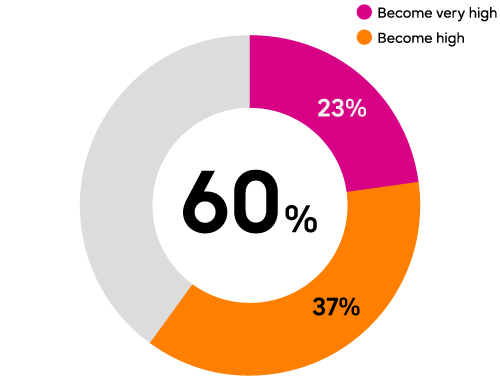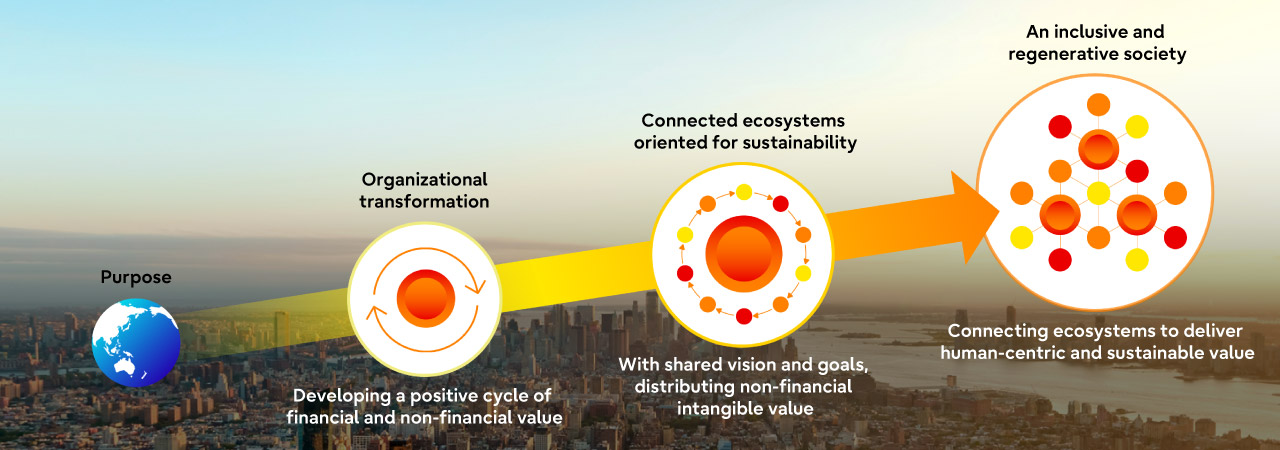Sustainability Transformation
Fujitsu Technology and Service Vision 2022
Fujitsu Technology and Service Vision 2022 provides insight into how CEOs and other business leaders can achieve sustainability transformation through digital innovation.
Fujitsu's vision for the future is based on technology that delivers change that matters in the real world and is led by purpose-driven leadership. Here we reveal the current trends driving business change based on our 2022 survey results.
Why do companies need to embrace sustainability transformation now?
Sustainability transformation is a growing management priority, and undoubtedly one of the most urgent issues for business leaders to tackle.
Our Global Sustainability Transformation Survey Report 2022 uncovers the challenges and success factors for CEOs and other business leaders to achieve sustainability transformation.

Sustainability is a top management priority
The mindset of business leaders toward environmental, social and economic sustainability has changed rapidly since the outbreak of COVID-19. According to Fujitsu’s commissioned survey conducted by Forrester Consulting among 1,800 business leaders across nine countries*1, sustainability is now a higher priority in 60% of organizations compared to two years ago. 41% of respondents told us that sustainability is one of their top three management priorities. For one in six organizations, sustainability is their top management priority.
Change in the priority of
sustainability in your organization
over the last 24 months

Sustainability is top 3 management priority

The primary reason for this change is the growing awareness of sustainability among younger generations. Millennials and Generation Z*2 account for about 60% of today’s working age population. In order to attract and retain talent, organizations need to build empathy with these generational groups. They also need to respond to new government regulations and guidelines, and meet growing customer demands for more sustainable solutions. Many business leaders now understand that improving sustainability is crucial to increasing the value of their organizations and services.
Reasons that the priority of sustainability has risen
Source: Fujitsu’s commissioned survey conducted by Forrester Consulting in February 2022
Without doubt, sustainability is now a global imperative that organizations must address to achieve mid to long-term growth.
*1 Fujitsu’s commissioned survey conducted by Forrester Consulting about sustainability transformation among CxOs and decision makers in Japan, Singapore, China, Australia, United States, United Kingdom, Germany, France and Spain in February 2022. (An online survey with partial interviews)
*2 In this document Millennials is defined as the generation born from 1981 to 1996, and Generation Z is defined as the generation born from 1997 to 2012.
Sustainability Transformation
Many organizations have already embarked on sustainability transformation.
In many cases, they are integrating sustainability into their business operations well beyond the scope of traditional CSR activities. To make a positive impact on the environment and society, 60% of organizations are already proactively transforming the processes by which they produce products and services. In addition, 45% of organizations have improved the value of their products and services.
Our survey revealed that half of all organizations have set out a sustainability vision, planned an organization-wide strategy and started implementation of the strategy as an integral part of their business. Moreover, one in five organizations is already achieving tangible outcomes from sustainability transformation.
However, only 5% of organizations are true leaders, executing mature sustainability transformation practices. What are these organizations doing?
Non-Active
Non-Active
Followers
Next Leaders
Leaders
Source: Fujitsu’s commissioned survey conducted by Forrester Consulting in February 2022
Key to success
Through the survey, we have found that purpose-driven leadership is the most important and fundamental driver of sustainability transformation. In addition to setting out an organizational purpose focused on sustainability, CEOs need to evangelize their purpose, encouraging their people to take positive actions to achieve it.
Organizations that are leading in sustainability transformation empower their employees based on their purpose. They use data and digital technology, as well as open ecosystems, to execute transformational actions and deliver outcomes.

Purpose Driven
- Set out a sustainability-oriented purpose and execute an organization-wide strategy under the strong leadership of the CEO
- Set out financial and non-financial goals and KPIs
Human Centric
- Help employees to acquire relevant skills
- Empower employees to deliver innovation in agile ways
- Cultivate and realize sustainability ideas from employees across the organization
- Nurture a culture of trust and empathy
- Promote diversity and inclusion
Data Driven
- Use methodologies such as agile development to improve sustainability
- Use data to create new solutions, continuously improving sustainability value
- Manage organizational data on sustainability in an integrated way, making decisions based on the data
- Securely protect the private data of customers, employees and partners
- Transform business processes to improve sustainability by integrating data and digital technologies
Connected
- Establish an open ecosystem, sharing goals and KPIs
- Share trusted data among ecosystem partners to create sustainability value
- Collaborate and develop partnerships proactively with public sector organizations
- Engage in sustainability-related policy making
Source: Fujitsu’s commissioned survey conducted by Forrester Consulting in February 2022
Digital-first sustainability
Data and digital technology are essential enablers of sustainability transformation. In our survey, two out of three organizations told us that digital is already helping them to implement sustainability transformation and that they plan to increase their investment in data and digital technologies to support their sustainability initiatives.
For example, some organizations are using digital technology to monitor CO₂ emissions in their organizations and across their value chain. Some organizations also use digital to provide traceability of food or materials, while others are deploying it to enable financial inclusion and more personalized services.
Digital transformation will help organizations to
implement sustainability transformation

Plan to increase investment in data and
digital technologies to support
sustainability initiatives

Our survey has also revealed a very strong correlation between digital transformation and sustainability transformation. We found that sustainability transformation leaders also tend to be more mature in their digital transformation practices, typically already delivering tangible outcomes.
A digital-first approach for sustainability transformation is clearly extremely important.
The leaders in sustainability transformation also show the highest maturity in digital transformation

* Including leaders and next leaders
Source: Fujitsu’s commissioned survey conducted by Forrester Consulting in February 2022
How to overcome challenges
Sustainability transformation is not an easy path. The scope of change might be enormous, requiring mid-to-long term commitment. In the short term, delivering financial value through increasing revenue and profits may be at odds with providing non-financial value to the environment and society. It is very important to clearly define both financial and non-financial KPIs, navigating them to ensure they positively impact each other, driving a growth cycle.
Challenges of sustainability transformation
Source: Fujitsu’s commissioned survey conducted by Forrester Consulting in February 2022
Management must respond to internal resistance and skepticism, ensuring that their vision, strategy and initiatives are well aligned. Creating the right employee mindset and corporate culture is essential to success.
Source: Fujitsu’s commissioned survey conducted by Forrester Consulting in February 2022
A journey to a sustainable world
In our survey, most of the organizations leading in sustainability transformation believe that their sustainability transformation activities have improved value for their shareholders, employees, customers, environment and society, in addition to positively impacting financial measures such as revenue, profit and market capitalization. In Fujitsu Technology and Service Vision 2021, we predicted that Business to Everyone (B2E), a new organizational model that maximizes value for multiple stakeholders, is emerging. These sustainability leaders are the early adopters of the B2E model.
In order to address our environmental, social and economic challenges, organizations need shared sustainability visions and goals, creating ecosystems that exchange non-financial intangible value and provide the foundations for a more regenerative society. This is the roadmap for the next 10 years.

Survey Report 2022








